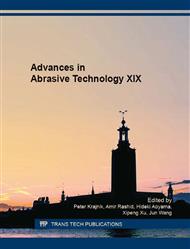p.429
p.433
p.439
p.445
p.450
p.457
p.463
p.469
p.475
Experimental Investigation of Heat Partition Ratio for the Cutting Tool at a Cutting Speed Ranging from 38 to 6500 m/min
Abstract:
This paper investigated the variation in a heat partition ratio of the cutting tool with the cutting speed ranging from 38 m/min to 6500 m/min. The orthogonal high-speed cutting experiment was performed utilizing an impact cutting tester developed. The cutting length in this study was 60 mm. The temperatures at the tool-chip interface were measured directly with three pairs of Cu/Ni micro thermocouples fabricated on the rake face. The temperature rises rapidly from the beginning of cutting, and then levels off when a cutting distance exceeds about 10 to 20 times the depth of cut. The distance depends on the cutting speed. Using the temperatures measured, a variation in the heat partition ratio with cutting time was estimated with the aid of a FEA. The heat partition ratio at the end of cutting estimated decreases approximately from 7 % to 1 % as the cutting speed increases from 38 m/min to 6500 m/min. The heat partition ratio estimated is quite higher than that calculated by employing an analysis assuming the steady state, particularly under the high speed cutting conditions.
Info:
Periodical:
Pages:
450-456
Citation:
Online since:
October 2016
Authors:
Keywords:
Price:
Сopyright:
© 2016 Trans Tech Publications Ltd. All Rights Reserved
Share:
Citation:


